Multiple unprecedented issues may arise during a construction project to warrant the termination of ongoing activities. Examples of such issues include safety concerns, regulatory non-compliance issues, legal disputes, etc. Termination can be done through a stop work order. Since a lot of legal and contractual requirements have to be bypassed to halt activities, the order must be formal and legally enforceable.
A template can be used to create the stop work order to ensure all relevant components needed to make the document legally binding are included. In addition, it will ensure that the process of halting activities is straightforward, clear, and consistent. This allows corrective actions to be taken promptly and prevents potential legal and financial liabilities that may result from the identified issues.
This article discusses what stop work order is and the key elements included in a template for creating such a document. It also defines different types of templates used to stop different projects.
What is a Stop Work Order?
A stop work order is a written directive issued by the authority overseeing a construction project.
It is issued to prevent the continuation of all operations until an investigation into the project has been completed. Moreover, its issuance gives time to resolve or mitigate safety concerns, legal issues, regulatory violations, and the risk of any negative outcomes such as accidents or injuries.
For example, a project is being undertaken to expand the capacity of a local highway, and there is a change in climatic conditions that can endanger the lives of the worker. Then, a stop work order can be issued to halt work for a while until the conditions are conducive.
Once issued, it must be complied with immediately else the project will be subjected to applicable legal and financial consequences.
note
Two types of stop-work orders can be issued for any project. These include partial (PSWO) and full (FSWO).
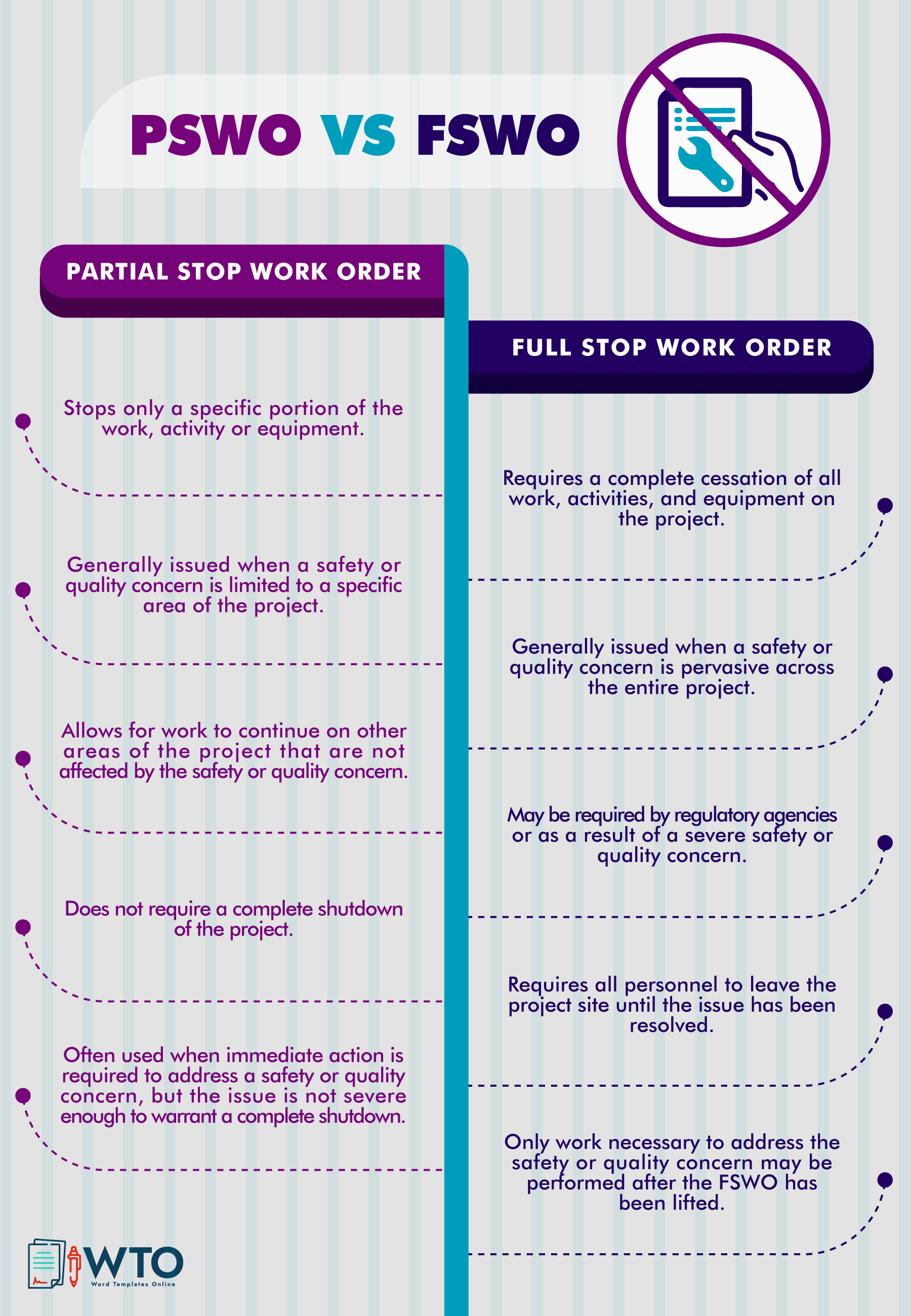
Free Templates
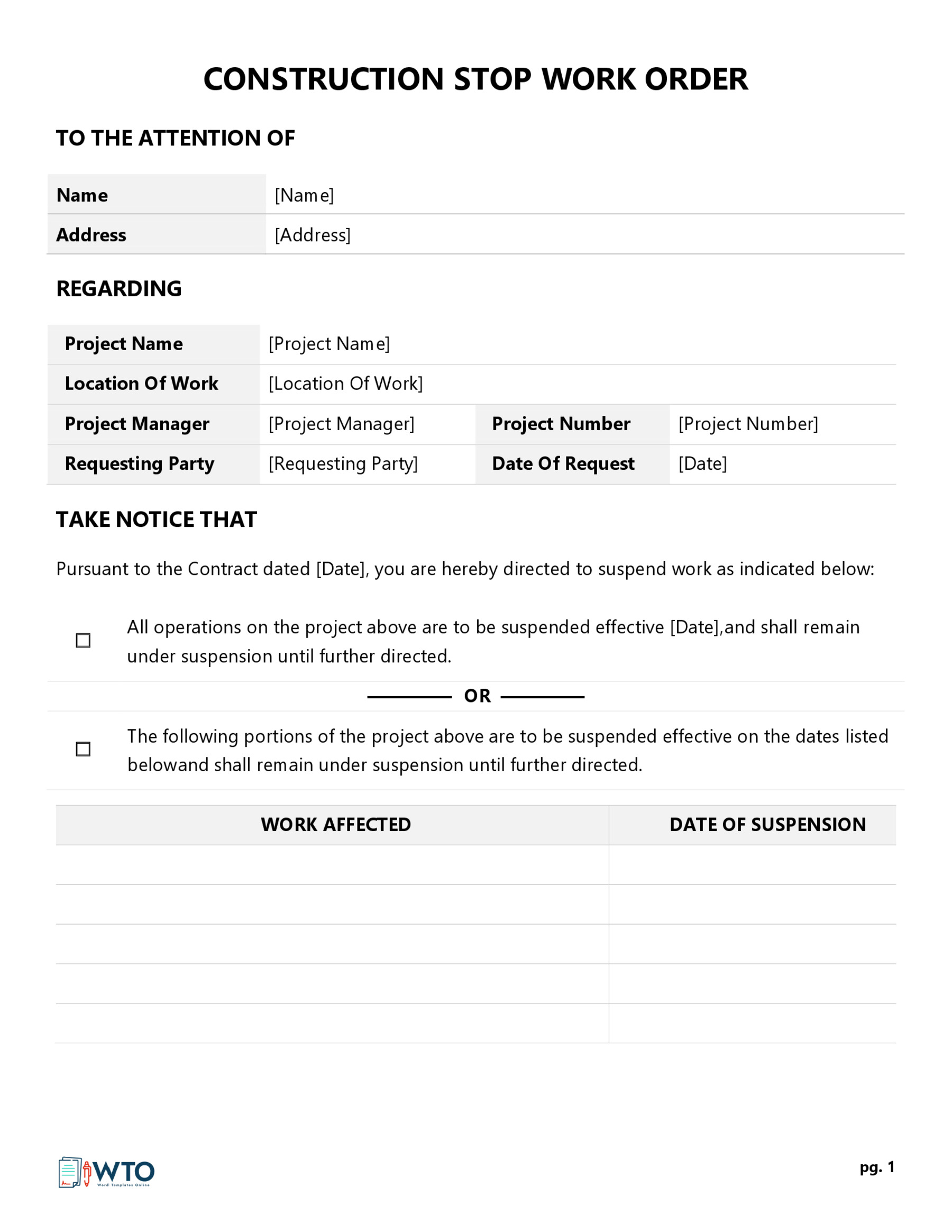
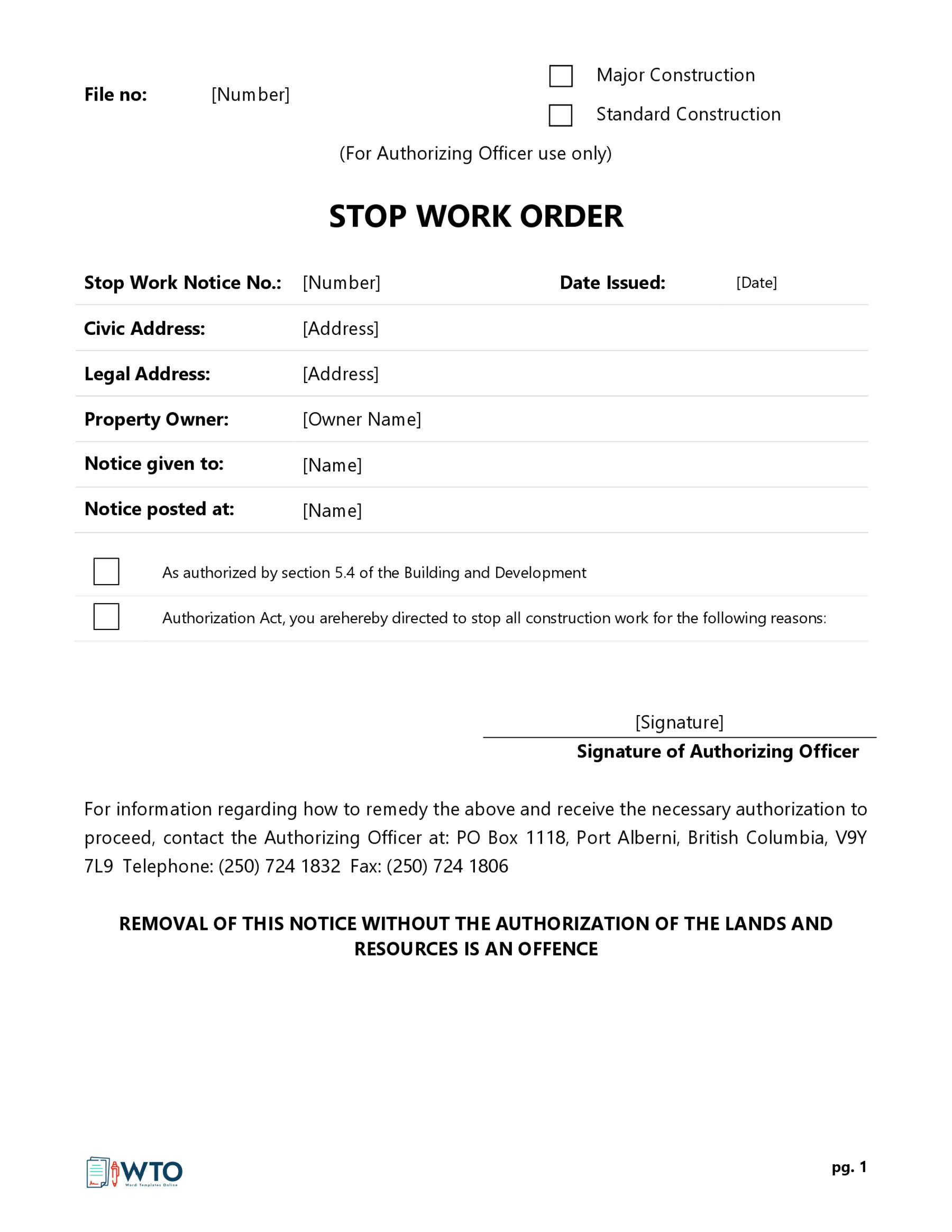
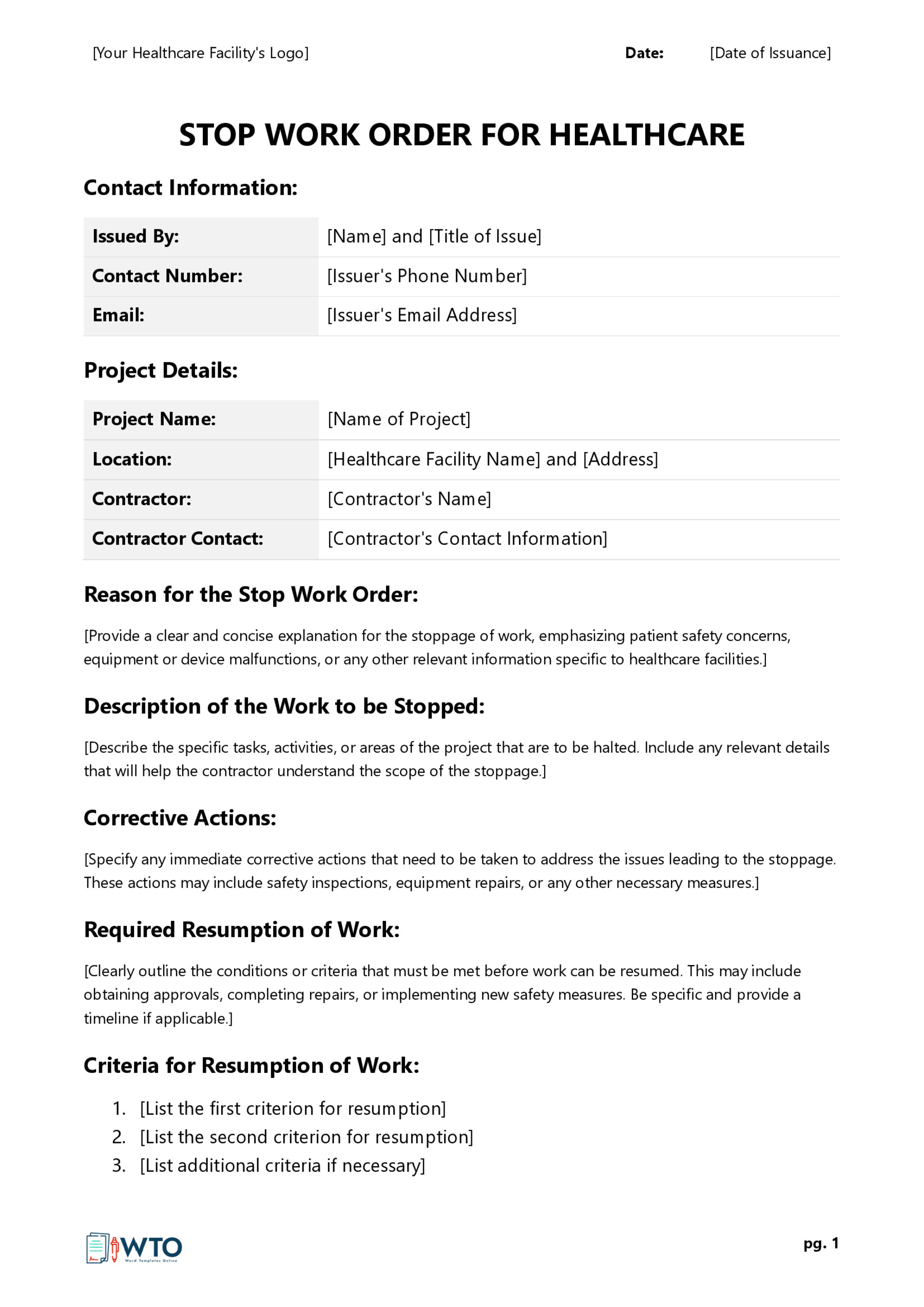
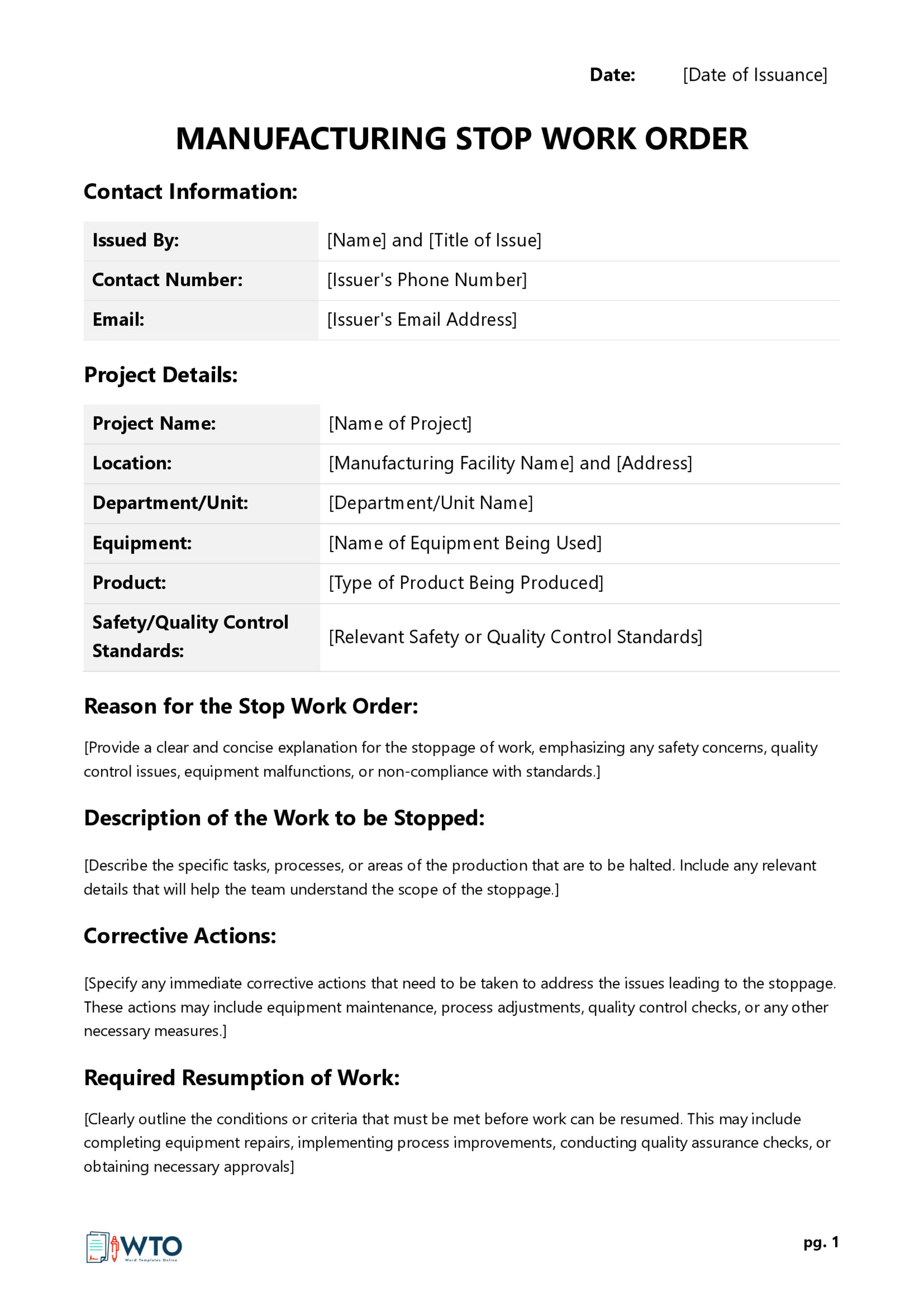
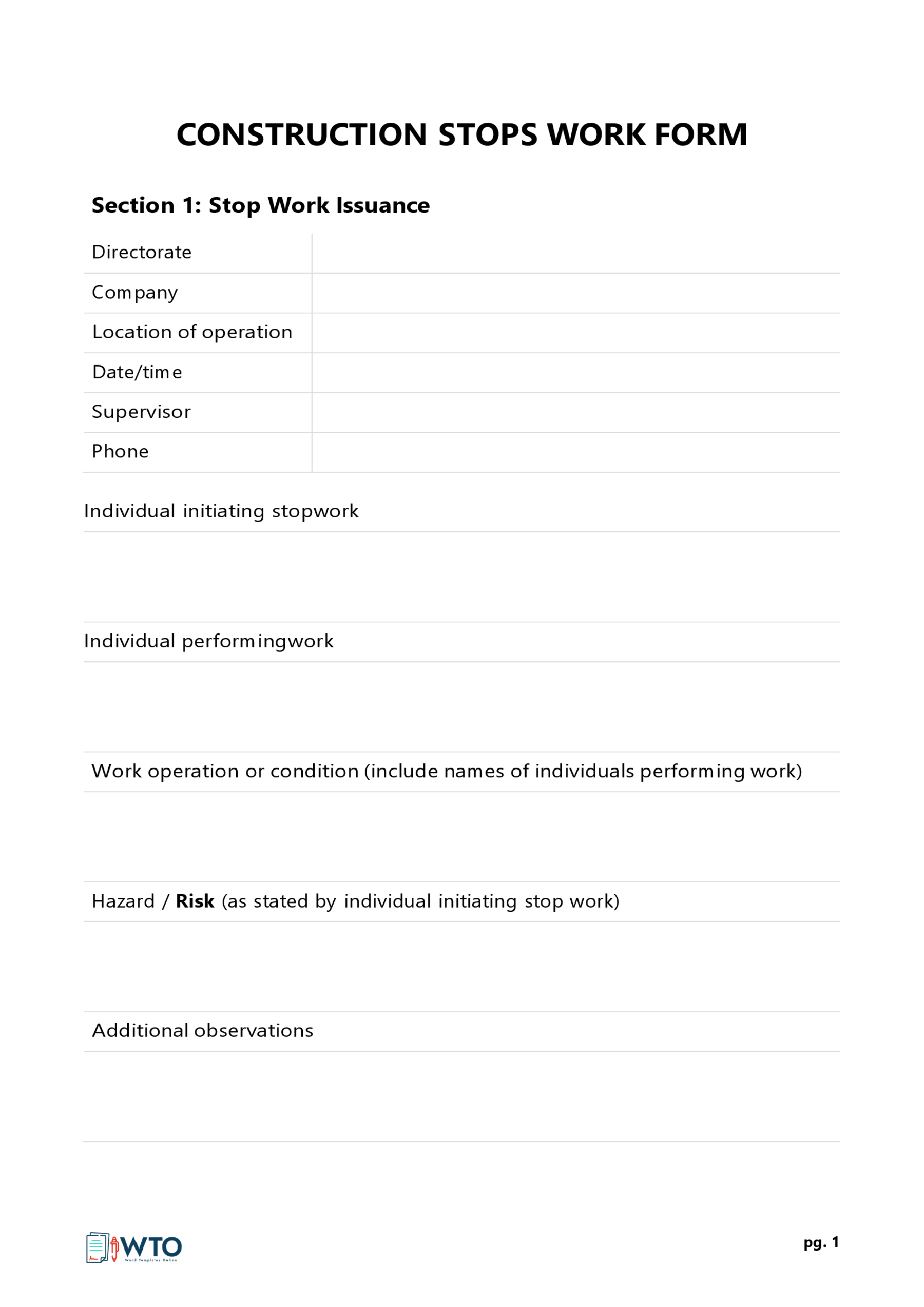
Key Elements of a Stop Work Order Template
A stop work order typically describes deviations or issues in question, all activities to be ceased, and clear and explicit instructions for discontinuation. Therefore, a template should have fields to provide this information and any other details that may be relevant to the directive. This way, there is standardization and consistency in how such orders are relayed to avoid miscommunication.
Below are key elements presented in such a template:
Contact information
The template should have an entry for your contact information and those of all the parties addressed in the stop order. This may include the safety inspector, legal representative, etc., for each identified party, indicate the name, phone number, and email address.
Project details
This section is meant to record the identifying details of the project. Such information includes the project title, location, scope, and timeline. This information lets the recipients know which specific project is being referenced in the document.
Reason for the stop work order
The stop order must clarify the specific reason necessitating the stop work order. Therefore, the template should have fields for regulatory violations, safety concerns, health issues, deviations from contract specifications, etc.
Description of the work to be stopped
All the activities to be halted should be identified and described explicitly to ensure everyone understands what they can and cannot do during the discontinuation period. A suitable template will thus have entries to document this information. This work can be the entire project or part of it.
Corrective actions required
The corrective actions are all the steps and tasks that need to be undertaken or implemented to resolve the previously identified issue before resumption. Therefore, this section of the template should thus be used to record the repairs, inspections, documentation, settlement, compliance, etc. The instructions should be clear and concise to guide the entire team on how to correct the deviations.
Resumption of work criteria
Typically, certain criteria have to be met before work can resume. These criteria indicate the successful correction of the identified issues. Therefore, the template must have fields to record any inspections, tests, or assessments that will have to be conducted. These entries collect information used to ascertain that the project has complied with the applicable laws, regulations, standards, or requirements.
Signatures of relevant parties
You and all relevant parties, such as the inspection officer, stakeholders, or representative of the regulatory agencies, must sign an order to stop work to make it legally binding. Therefore, the template must have sections for all signatories to provide their names and signatures. Signatures indicate that all stakeholders are aware of the stop order and agree to implement the corrective actions before the resumption of work.
Types of Stop Work Order Template
Different types of templates are available to guide project managers in different industries to create stop work orders. You can download such printable templates from our site. They are premade with sections specific to each industry. However, they can be customized to suit each situation.
Common types of templates for making stop work orders include the following:
General stop work order template
This is a generic template that can be used to create stop-work orders in different industries. It contains basic elements such as project name, reason for discontinuation, location, date, description of the halted work, corrective actions, and signatures.
Construction stop work order template
Such a template is predesigned for construction projects. It contains entries for the location of the work site, the type of work being stopped, the equipment being used, and the violated safety regulations or requirements. This template will also have entries for the resumption of work criteria, such as inspections and permits needed to verify that the issues were resolved.
Manufacturing stop work order template
This type of template is used to stop work in manufacturing and production projects. It will have placeholders for the type of equipment used, the product being manufactured, and the relevant safety and quality standards that must be adhered to.
Healthcare stop work order template
This printable template is used to halt medical projects due to legal or regulatory concerns. It will have entries for the identified medical issue, equipment or device malfunctions, relevant standards, and any other useful information.
Best Practices for Using a Stop Work Order Template
A template has multiple benefits that can be realized if it is effectively used to stop work on a project. Some of the things you can do to ensure you benefit from such a template include:
Ensure all relevant parties are aware of the template
You should inform everyone involved in overseeing different parts of the project that the template is available and its importance. In this regard, you can hold training sessions for the contractors, key stakeholders, and safety inspectors. Also, add the template in the project manuals and documentation to make it easy to access.
Train employees on the proper use of the template
Train employees on how to use the template to create stop work orders properly. This will ensure that it is correctly used and consistently filled. The training sessions may focus on different topics specific to your project or team’s needs. Examples of such topics include how to identify safety or regulatory issues, complete the template, and formulate feasible corrective actions.
Regularly review and update the template
Always review and update the template to tailor it to any changes in the project plan, laws, and regulations. You can do so by adding or removing elements in its basic layout. You can also revise the instructions and wording. This will make it more relevant and effective in creating stop-work orders.
Store the template in a centralized location for easy access
Keep the template in an easy-to-access and centralized location. You can use a shared drive or project management system. Then, permit all relevant parties to access the template. This will make crafting, issuing, and implementing stop-work orders easy.
Use the template consistently across projects
You can use the same template across all the projects you are managing. This will ensure you do not forget any key information needed to execute a stop work order. Also, this promotes consistency once all parties understand how to use the specific template.
Important Measures to Take for Creating Stop Work Order Templates?
A stop work order is a formal and legally binding document. So, a lot of considerations have to be taken into account when making a template to ensure projects can be halted promptly and effectively.
Important factors you should consider to make the template more effective include:
Identify the relevant information to include
The template should have sections for all the relevant information needed to precisely document the stop work order. Examples of basic information that ought to be considered include:
- Project identification details
- The contact information of relevant parties
- The reason for the order
- A description of halted work
- Corrective actions needed
- Resumption of work criteria
- Signatures
Consider the specific needs of the project or organization
Each project and organization will have specific needs in terms of formatting, language, safety and regulatory requirements, terminology, etc. The associated template should be customized to satisfy these needs.
Incorporate any relevant regulations or legal requirements
Always review and understand the applicable law and regulations relevant to the project. Then, create a template that complies with these guidelines. For example, ensure to review OSHA requirements, personal protective equipment (PPE) rules, quality control, etc.
Test the template with relevant stakeholders
After crafting the template, distribute it to potential users such as safety inspectors, team leaders, investors, legal representatives, etc. This is done so that users can review it and ensure it meets their needs for creating a stop work order. Collect their feedback and modify where necessary.
Make necessary revisions
As the template is being used, collect feedback from all users and revise the document if necessary. This increases its effectiveness and usability. Ensure to review it regularly as changes occur.
Final Words
A template is an effective approach to stop work on ongoing projects consistently. This is because it is predesigned in a standardized format and layout to ensure all the necessary information is included. This reduces confusion and errors and improves the efficiency of halting activities. Such printable templates can be obtained from our site.
The template helps you and the team address regulatory and legal concerns to ensure the project is compliant upon completion. Consequently, this mitigates the risk of fines and accidents during a project. Also, workers can be protected through any laws and regulations imposed by industry regulators or government agencies.




